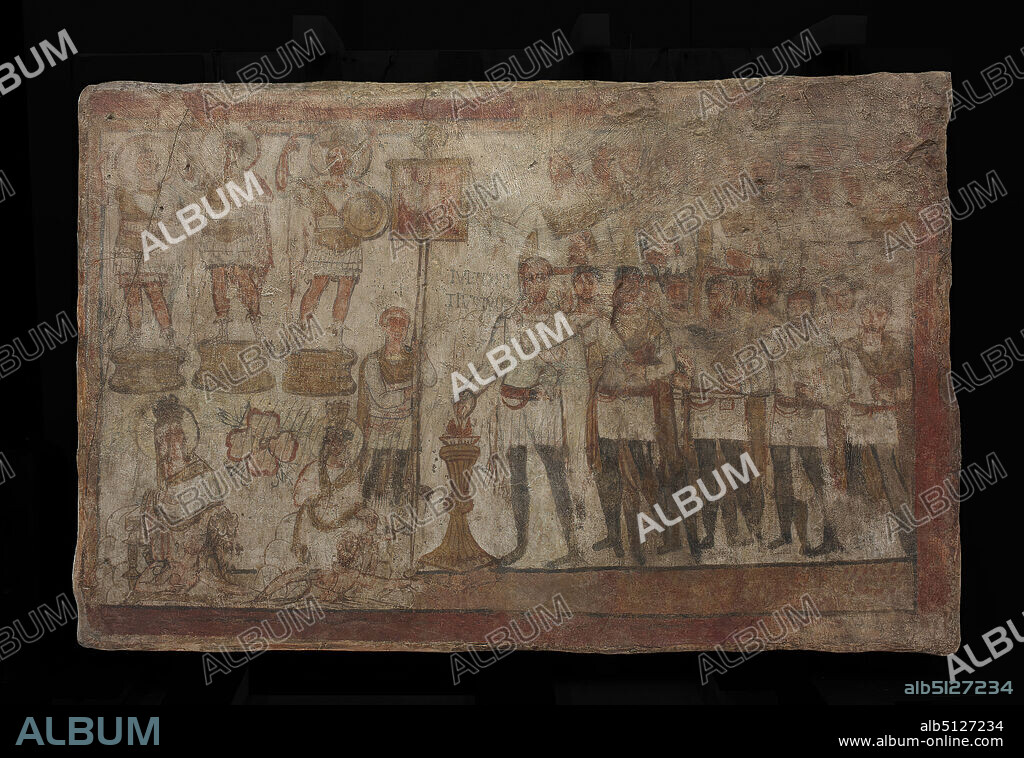alb5127234
Julius Terentius Performing a Sacrifice, A.D. 239, Paint on plaster, 107 × 165 × 10.2 cm, 87.54 kg (42 1/8 × 64 15/16 × 4 in., 193 lb.), Yale-French Excavations at Dura-Europos, Commissioned by the Roman tribune at Dura-Europos, Julius Terentius (depicted and identified here by Latin inscription), this painting mixes Greek, Roman, and Palmyrene elements, perhaps as a gesture of diplomacy. Performing an official sacrifice in front of a military standard, Terentius stands with his men. Although in Roman military attire, these soldiers are Palmyrenes; one of them (Themes, son of Mokimos) is identified in Greek as a priest. The sacrifice, a burning of incense, was an act of worship common in both Near Eastern and Roman sanctuaries. Here it takes place in the presence of divinities, all nimbate. The Tychai of Dura and Palmyra are shown in Hellenistic style incorporating some Near Eastern features. Three male statues of deities enigmatically combine Roman cuirasses and Palmyrene attributes (such as the peaked helmet). Their lack of identifying labels creates ambiguity as to whether they represent Palmyrene gods or deified Roman emperors. This may have been done intentionally, to appeal to viewers of different backgrounds. , Excavated in Dura-Europos, Syria, Syrian, Dura-Europos, Roman (3rd century A.D.), Paintings.

|
Ajouter à une autre Lightbox |
|
Ajouter à une autre Lightbox |



Avez-vous déjà un compte? S'identifier
Vous n'avez pas de compte ? S'inscrire
Acheter cette image.
Sélectionnez l'usage:

Légende:
Voir la traduction automatique
Julius Terentius Performing a Sacrifice, A.D. 239, Paint on plaster, 107 × 165 × 10.2 cm, 87.54 kg (42 1/8 × 64 15/16 × 4 in., 193 lb.), Yale-French Excavations at Dura-Europos, Commissioned by the Roman tribune at Dura-Europos, Julius Terentius (depicted and identified here by Latin inscription), this painting mixes Greek, Roman, and Palmyrene elements, perhaps as a gesture of diplomacy. Performing an official sacrifice in front of a military standard, Terentius stands with his men. Although in Roman military attire, these soldiers are Palmyrenes; one of them (Themes, son of Mokimos) is identified in Greek as a priest. The sacrifice, a burning of incense, was an act of worship common in both Near Eastern and Roman sanctuaries. Here it takes place in the presence of divinities, all nimbate. The Tychai of Dura and Palmyra are shown in Hellenistic style incorporating some Near Eastern features. Three male statues of deities enigmatically combine Roman cuirasses and Palmyrene attributes (such as the peaked helmet). Their lack of identifying labels creates ambiguity as to whether they represent Palmyrene gods or deified Roman emperors. This may have been done intentionally, to appeal to viewers of different backgrounds. , Excavated in Dura-Europos, Syria, Syrian, Dura-Europos, Roman (3rd century A.D.), Paintings
Personnalités:
Crédit:
Album / quintlox
Autorisations:
Taille de l'image:
4992 x 3435 px | 49.1 MB
Taille d'impression:
42.3 x 29.1 cm | 16.6 x 11.4 in (300 dpi)
Mots clés:
ANT. OR.: SYRIE • ARMEE: SOLDATS • ART ROMAIN • ART SYRIEN • EASTERN • EPOQUE ROMAINE • FILS NATUREL • FILS • GESTE • GESTUALITE • GREC • GRECE HELLENISTISQUE • GRECQUE • HELLÉNISTIQUE • PL? TRE • ROMAIN • SACRIFICE • SOLDAT DE L'ARMEE POPULAIRE NATIONALE • SOLDAT • SYRIAN • SYRIE • SYRIE, ANT. OR. • SYRIEN
 Pinterest
Pinterest Twitter
Twitter Facebook
Facebook Copier le lien
Copier le lien Email
Email
